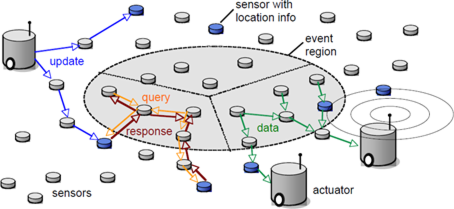Section: Application Domains
Networked robots
Both economically and scientifically, cooperation in robot swarms represents an important issue since it concerns many service applications (health, handicap, urban transports...) and can increase the potential of sensor networks (Integrating wireless sensor networks and multi-robot systems increases the potential of the sensors: robots, in comparison, are resource-rich and can be involved in taking decisions and performing appropriate actions on themselves on sensors and/or the environment.). It involves several challenges such as:
- Because autonomy is a key for being able to increase the network size, maximize the autonomy of the robots in their different tasks of localization, motion, communication;
- Aiming at making 1+1 be more than 2, extend the global potential of the swarm by introducing collaboration (exchanging information with other robots) and cooperation (acting with other robots);
- Include time and energy saving considerations at the design stage.
The self deployment of autonomous groups of mobile robots in an unknown environment (including different kinds of static or moving obstacles) involves localization, path planning and robust control problems. Both the control and signal aspects of our researches are oriented to solve some problems coming from or taking advantage of such collaboration frameworks. To mention a few:
- Localization using as few as possible landmarks and exteroceptive information by means of derivative estimates;
- Image-based sensing algorithms inspired by our multidimensional estimation techniques;
- Detection and adaptation to sudden loss of communication, time-varying topology, or communication delays;
- Robust, autonomous, energy-aware controllers based on either model-free or model-based techniques.
Several algorithms have already been applied to the control of formations of mobile robots: an illustrative platform is currently developed at EuraTechnologie center within the framework of Non-A (“RobotCity” was exhibited for the first time during the opening ceremony held on April 6th, 2011). They are now being extended to medical devices (such as wheelchairs) within the European project SYSIASS (see http://www.sysiass.eu ), in collaboration with partners from hospital settings.
Another future application concerns Wireless Sensor and Robot Networks (WSRN, Fig. 2 ), dedicated to the surveillance of zones, to the exploration of hostile areas, or to the supervision of large scale sensor networks. The main idea here is to integrate mobile nodes (the mobile robots) within the sensor network, allowing to overcome a sensor defection, to maintain the connectivity of the network, or to extend the coverage area during a random deployment. This involves consideration about mobile actuators within a mobile network of sensors and control networks (wireless) with strong constraints on the possibilities of communication in a noisy and non-homogeneous environment. This work is made in close collaboration with the Inria project-team POPS (Lille), which brings its expertise in terms of sensor networks. It takes place in the framework of the Inria ADT SENSAS and represents our contribution to the LABEX proposal ICON.


